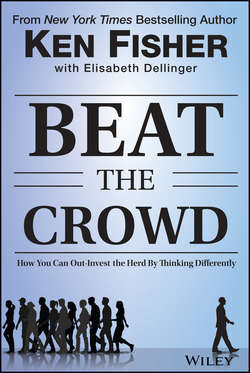Читать книгу Beat the Crowd - Kenneth Fisher - Страница 7
На сайте Литреса книга снята с продажи.
CHAPTER 1
Your Brain-Training Guide
The Curmudgeon’s Conundrum
ОглавлениеTwo-herd contrarians see the world like an analog clock. They base bets on wherever the main herd expects the hand to land. If everyone says the clock will point at 1, the supposed contrarian herd bets it’ll land on 7 – roughly the mirror opposite direction. Just because it’s the opposite! Contrary for contrary’s sake. Much of the time, no real extra thought goes into it. Just a curmudgeonly instinct. “Everyone’s cheery, so I can’t be.” It wouldn’t occur to curmudgeons to consider other alternatives, like “Everyone’s cheery, but maybe they should be even more so!” This isn’t physics, where for every action there is an equal and opposite reaction. Assessing markets and events based on a false either/or could lead to big mistakes when you consider results are not binary.
Transferring our clock metaphor to stocks, if the crowd thinks stocks will rise 10 % in a year, the curmudgeons bet on down. Perhaps not down 10 % exactly – they’ll bet on the opposite direction, but they might not bother guessing the magnitude. Their nature is to be ornery, but not ornery with precision. Simply betting the reverse direction is good enough for them.
We can transfer it to a recent scenario, too, like the Federal Reserve’s quantitative easing (QE). The crowd thinks QE is good, propping up stocks. Contrarians think it’s bad, risking inflation. Here is your false either/or! In my view, QE is bad because it is deflationary, an outcome neither the crowd nor the supposed contrarians consider. There is a century of economic theory and research supporting this notion, but the crowd buys the common narrative, which crowd-contrarians are so fast to categorically reject that they miss the truly big problem with crowd-think. There, too, they’re just being an opposite crowd without much deep thought. (More on QE later.)
What’s the problem? A clock doesn’t have just two numbers! It has 12 hours, with 60 minutes in between. Even if the masses bet wrong, the curmudgeon has a 10-in-11 chance of being wrong, too. That’s a 1-in-11 chance of being right. Same goes with markets. If everyone calls for a 10 % year, stocks need not end down for them to be wrong. Flat returns would do it. So would up 20 %, 30 % or more, because most who envisioned 10 % would have sold out by the time stocks hit 15 %. The curmudgeons who bet on down could very easily be wrong – and often are. Not that being wrong would hurt if you called for 10 % and stocks did 30 %, if your positioning was right and you didn’t sell too soon, but we’ll get to that in Chapter 2.
